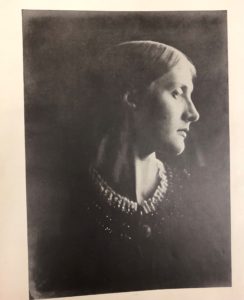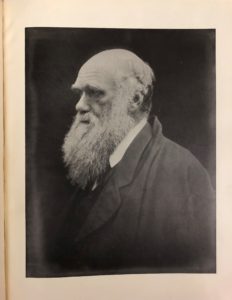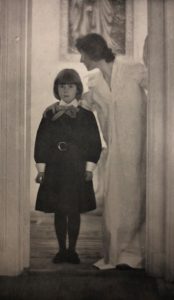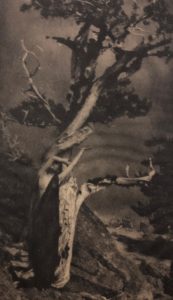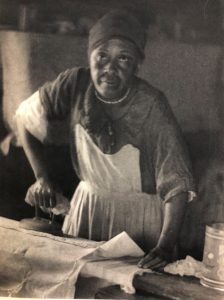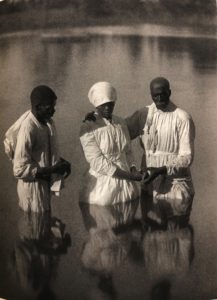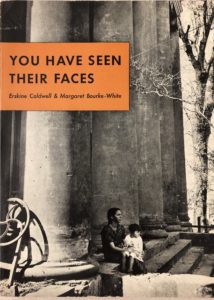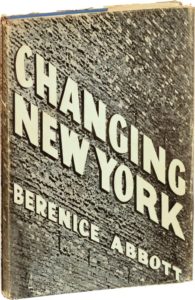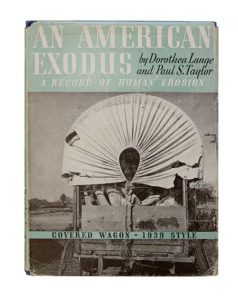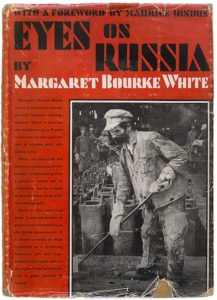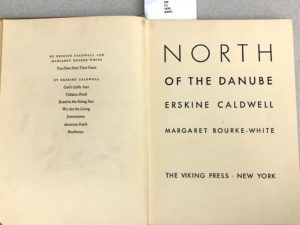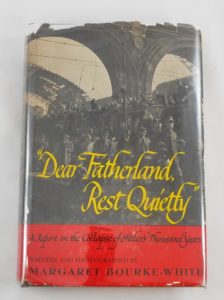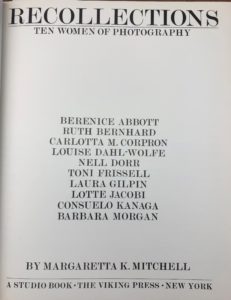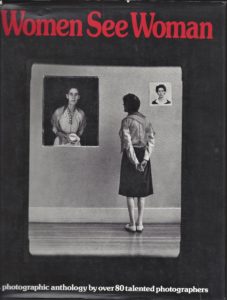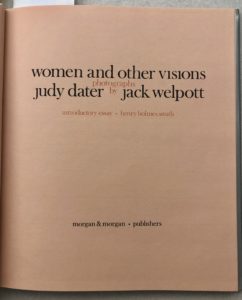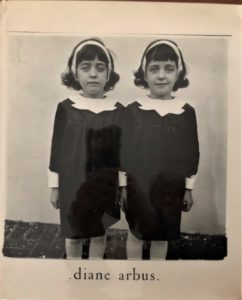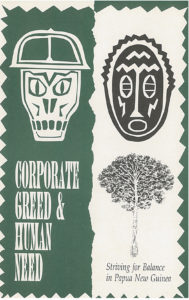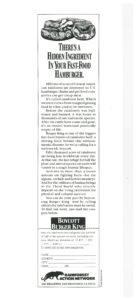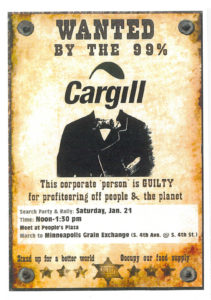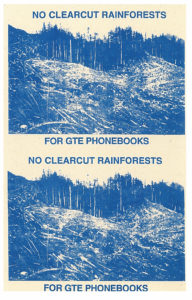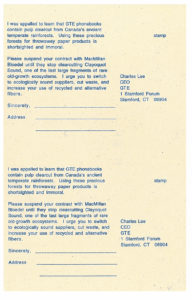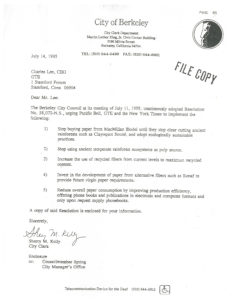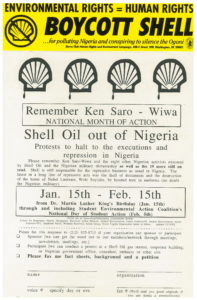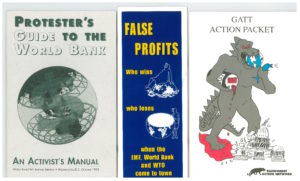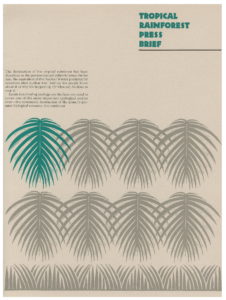Tag: Bancroft Library
Photobooks by Women in the Reva and David Logan Collection
A posting by Christine Hult-Lewis, Ph.D., Reva and David Logan Curatorial Assistant
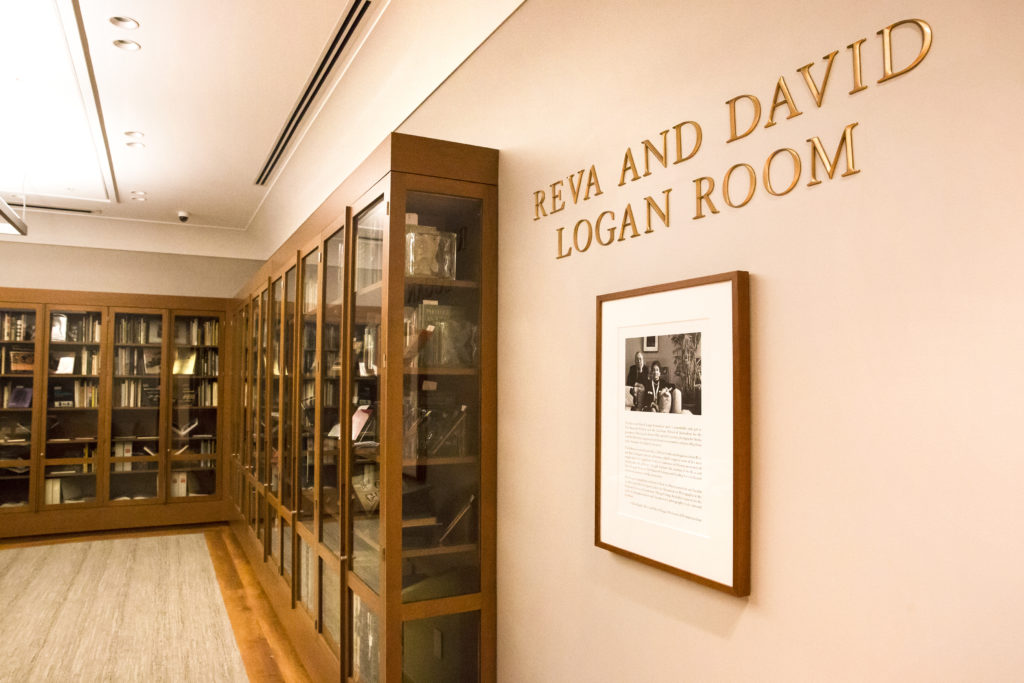
Tucked in the shelves of the Bancroft Library’s Reva and David Logan Collection of Photographic Books are some exceptional photography books by women photographers. Books illustrated with photographs were and are incredibly important in the history of photography: they are the best means to disseminate an artist’s work, are more readily available than photographic prints, and can wield an outsize influence in the public arena. Here is a selection of some of the most significant books by women in the collection.
EARLY MASTERS
One of the best known and most influential photographers of the nineteenth century is Julia Margaret Cameron, whose insightful and penetrating soft-focus portraits redefined the genre. Cameron was most interested in getting at the “truth” and “beauty” of her subjects; her best portraits strip away all context in favor of a focus on the face itself, as in the above image of her niece Julia Jackson (Virginia Woolf’s mother). Some forty-seven years after Cameron’s death, Victorian Photographs of Famous Men and Fair Women was published by Woolf, who also contributed an introduction.
Most women didn’t produce their own books until the early decades of the twentieth century, but some shared their work in the pages of Camera Work. This seminal photography periodical, edited by Alfred Stieglitz from 1903-1917, regularly featured women in its pages, such as Gertrude Käsebier, whose work appeared in the inaugural issue, and Annie Brigman. Both used the familiar techniques of Pictorialism—soft focus, romantic subject matter—in their beautifully printed photogravures. Each addressed different aspects of the female experience: Käsebier emphasized the maternal bond and motherhood, while Brigman focused on the symbolically-charged interplay between women’s bodies and the natural world.
The Pictorialist aesthetic championed by Käsebier, Brigman, and others would continue into the 1920s and 30s with photographers like Doris Ulmann. Ullman was interested in rural America and folk cultures, part of a general reassessment of what constituted authentic “American-ness” during the 1930s. The result was the 1933 collaboration Roll, Jordan, Roll, with Ullman providing the delicately-printed photogravures and author Julia Peterkin providing text. The book describes the lives of the Gullah people, many of whom were former slaves living in the coastal areas of South Carolina and Georgia. Ulmann’s images provide a sensitive and nuanced portrayal of lives lived in quiet dignity.
DOCUMENTARY PHOTOBOOKS OF THE 1930s
Some of the most influential photographic books of the Depression era were by women. Margaret Bourke-White’s You Have Seen Their Faces concentrated on what she and Caldwell perceived as the ongoing problems of the South: its extreme poverty, its pernicious and ongoing racism, and its damaged people. The book was popular, though it had, and has, its detractors, who objected to its condescending tone. By contrast, Dorothea Lange was one of the most respected practitioners of documentary in the 1930s, and made sure to give her subjects their own voice(s). Lange worked under the aegis of the US government-sponsored Farm Security Administration, taking photographs intended to help support the various projects of agricultural reform. This book was a true merger of empathetic, artistic images and dispassionate, statistical text. Another government-sponsored project, Berenice Abbott’s Changing New York, shifted the attention from rural people in distress to the changes and dislocations of that quintessential American city, New York. Abbott was particularly attuned to the beauties of the ever-changing city, and the transformations wrought by that peculiarly modern structure, the skyscraper.
PHOTOJOURNALISM
Margaret Bourke-White wasn’t really a documentarian; her true metier was photojournalism. She worked for the earliest pictures magazines in the United States, Fortune and Life. Bourke-White was the first photographer to go to Soviet Russia; sent there by Fortune in 1930, her experiences there became the book Eyes on Russia. Concurrently with her work on picture magazines, she wrote or co-wrote twelve books, five of them during the war years. She spent much of the war in the European theater of operations, where she became accredited as an official Army Air Force photographer. She worked incessantly, took all kinds of risks, made thousands of pictures, and managed to churn out books at an astonishing rate. North of the Danube recounts the months when Germany invaded Austria and Czechoslovakia, while Dear Fatherland, Rest Quietly attempts to grapple with the horrors of the Holocaust. The Logan Collection has fine examples of every one of her books.
THE 1970s
By the 1970s, the lack of women in the photographic canon did not go unnoticed by women artists, feminists, and their allies, and they sought to redress this exclusion and promote a more inclusive point of view. This took place in not only in museum exhibitions but also in photobooks, including anthologies like these that sought to uncover the work of women photographers whose names had dropped off the radar of popular culture and photographic history.
New monographs by young photographers like Judy Dater explicitly explored gender, examining different conceptions of femininity, sexuality, and agency in portraiture. Dater’s work can be seen as a kind of modern extension of Julia Margaret Cameron, in her explorations of the human psyche through expression, gesture, and light itself. Diane Arbus—this book of her photographs would not be released until after her death in 1971–would redefine the documentary project with her highly-charged photographs in the 1960s. Like Bourke-White, she took risks and went where others dared not go; she could almost be described as a photojournalist of the psychological.
The Logan Collection is a wonderful resource to study the photobooks by women, as well as many other themes in the history of photography. I hope this brief overview of this collection sparks further study. For more information, see the online overview of the Logan Collection. Books are available for onsite use in Bancroft’s reading room, and can be requested from OskiCat via our online paging system.
Additions to the Rainforest Action Network Records Now Open at The Bancroft Library
At first I thought I was fighting to save the rubber trees;
then I thought I was fighting to save the Amazon rainforest.
Now I realize I am fighting for humanity.
– Chico Mendes (1944-1988)
The Bancroft Library is pleased to announce that a series of additions to the ongoing Rainforest Action Network records is now open and accessible to researchers. The processing of the Rainforest Action Network records is part of a two-year grant project funded by the National Historical Publications and Records Commission to make available a range of archival collections relating to environmental movements in the West. A leading resource in the documentation of U.S. environmental movements, The Bancroft Library is home to the records of many significant environmental organizations and the papers of a range of environmental activists.
Rainforest Action Network was founded in 1985 by Randy “Hurricane” Hayes and Mike Roselle as a San Francisco based non-profit grassroots environmental group with a mission to protect and preserve the world’s forests and defend the human rights of indigenous people and others affected by unjust land grabs and the depletion of natural resources. Rainforest Action Network’s direct action, education and marketing campaigns apply pressure to governments and corporations to halt illegal logging, manufacturing, selling and use of old growth trees and tropical forests.
The global breadth of Rainforest Action Network’s activities range from Old Growth campaigns in Northern California, the Pacific Northwest and Canada to Tropical Timber campaigns to protect forests and indigenous rights in Central and South America, Africa, Tasmania and Southeast Asia. They also include the Global Finance campaign which organized and supported civil disobedience during the World Trade Organization meetings in Seattle, Washington in 1999.
The Bancroft Library has been collecting Rainforest Action Network records since 2006 and the newly opened additions document the group’s campaigns primarily in the 1990s-2000s. Future additions to the records are expected.
From the Archives: C. Judson King
“Freeze-Dried Turkey, Food Tech, and Futures”
by Caitlin Iswono
Caitlin Iswono is a sophomore undergraduate student at UC Berkeley majoring in chemical engineering. In the Spring 2019 semester, Caitlin worked with historian Roger Eardley-Pryor of the Oral History Center and earned academic credits as part of UC Berkeley’s Undergraduate Research Apprentice Program (URAP). URAP provides opportunities for undergraduates to work closely with Berkeley scholars on the cutting edge research projects for which Berkeley is world-renowned. Caitlin provided valuable research for Eardley-Pryor’s science-focused oral history interviews this past semester. Caitlin’s explorations of the Oral History Center’s existing interviews resulted in this month’s “From the Archives” article.
“I had my turkeys. I think I may still have a piece of freeze-dried turkey that’s now fifty years old.”
— C. Judson King, “A Career in Chemical Engineering and University Administration, 1963-2013,” oral history interviews conducted by Lisa Rubens and Emily Redman, with Sam Redman, in 2011, Oral History Center, The Bancroft Library, University of California, Berkeley, 2013.

In 1963, at age 29, C. Judson “Jud” King was backpacking in California when a fellow Boy Scouts Master revealed he freeze-dried his food before weeklong trips to the Sierra Mountains with groups of ten to twelve people. While the levels of safety and sanitation were not like today’s freeze-dried food, this period in King’s early adulthood sparked a branch of his later academic research that opened new discoveries and advancements in the food-technology industry. Like King’s connection with hiking and freeze-drying, I also aspire to coalesce my personal interests—namely, in humanitarian aid—with research in food technology for my future career.
King, a professor emeritus of UC Berkeley’s Department of Chemical and Biomolecular Engineering, held positions in a wide variety of academic and administrative posts. Throughout his career, King served as the Provost and Senior Vice President of Academic Affairs of the University of California system, as Dean of the College of Chemistry at UC Berkeley, and as Chair of Berkeley’s Department of Chemical and Biomolecular Engineering. With over 240 research publications, including a widely used chemical engineering textbook, 14 patents, and major awards from the American Institute of Chemical Engineers, King has lived an accomplished life. But how did he get started in chemical engineering? And what might a chemical engineering student like me take from his experiences?
When asked in his 2011 oral history interview why he chose chemical engineering, King simply answered “I like chemistry. I like math. What should I look to major in college? The answer was chemical engineering.” King’s statement rings true for me, too. As an incoming freshman to Berkeley in 2017, I knew I would major in chemical engineering, but I was unsure what I wanted to do with this degree. In Cal’s rigorous chemical engineering program, I occasionally lost sight of the bigger picture. Constant midterm cycles, weekly problem sets, daily academic tasks, and my broader student activities all made it easy to avoid exploring why I’m pursuing my chemical engineering degree and what I hope to accomplish with it. However, learning from the experiences and insights of upperclassmen, graduate instructors, and my professors, I’ve found new purpose and aspirations for my future.
Not unlike King, I also became interested in food technology. My interest in food-tech began after attending Berkeley’s on-campus UNICEF Club and hearing guest lectures on the profound effects advanced food technology can have for developing countries. UNICEF is a United Nations organization charged with protecting children’s rights and helps over 190 disadvantaged territories around the world. It does so, in part, by incorporating food science and technology in their efforts to assist malnourished children, particularly with Ready to Use Therapeutic Foods (RUTF). Learning about this advancement sparked my interest in food science, similar to how hiking inspired King’s research transition to freeze-drying foods. King’s successful research and collaborations with companies such as Proctor and Gamble opened my mind to new possibilities. Reading King’s oral history interview and discovering his experiences in diverse fields within chemical engineering provided guidance on a possible career path for me.
King’s oral history also offered insight on different processes of freeze drying and how they influenced history. As King explained it, the development of freeze-dried techniques did not emerge from a desire for portable food. Rather, it arose from efforts to preserve medicines and blood plasma cells for medical reasons, particularly from isolating and stabilizing penicillin during World War II. Only after World War II ended did industries utilize freeze-drying to preserve foods. Industrial processors and academics like Jud King realized that freeze-drying techniques could apply to many fields, whether for military use, backpacking, space travel, or pharmaceuticals. These realizations have since inspired me to combine my passions for UNICEF advocacy and food technology to positively impact underdeveloped countries.
King’s interview reminded me that every person starts from somewhere and it’s okay to not have the entirety of life figured out from the very beginning. King’s interests in freeze-drying led to him becoming a renowned professor emeritus and former dean of Berkeley’s College of Chemistry. His story reminded me that the most anyone can do is strive to learn new things, try your hardest, and take on new opportunities. Your path and future track will then build itself.
— Caitlin Iswono, UC Berkeley, Class of 2021
Event: Bancroft Library Roundtable: Education as the Project of Freedom: A Study of the Berkeley Experimental Schools Project, 1968-76
The Bancroft Library Roundtable will take place in the O’Neill Room of The Faculty Club at noon on Thursday, October 18. Joanne Tien, doctoral candidate, Education, UC Berkeley, will present Education as the Project of Freedom: A Study of the Berkeley Experimental Schools Project, 1968-76.
___________________________________________________________
Educators and activists have long debated the relationship between constructivist pedagogical approaches — which emphasize the autonomous, self-directed construction of knowledge from a learner’s experience — and the cultivation of explicit political values that challenge systems of oppression. Joanne Tien will discuss her research on archival material at The Bancroft Library and how teachers and students in the Berkeley Experimental Schools Project (BESP) navigated this ideological tension. A public educational program that existed from 1968 to 1976, BESP sought to incorporate the goals of both the Free School and Black Power movements. This historical case study sheds light on the dilemma with particular clarity because the Free Schools represent one of the United States’ most radical experiments in constructivist learning, just as the Black Power movement promoted one of its most heightened efforts to challenge systemic oppression.
We hope to see you there!
José Adrián Barragán-Álvarez, Michael Maire Lange, and Kathi Neal
Bancroft Library Roundtable Coordinators
Event: Bancroft Roundtable: “A Wise Counselor and Faithful Servant: The Life of Regent Andrew Smith Hallidie”
The Bancroft Library begins the 2018-2019 academic year with a new series of roundtable talks. Please join us!
The first talk will take place in the Lewis-Latimer Room of The Faculty Club at noon on Thursday, September 20. Taryn Edwards, librarian, historian, and strategic partnerships manager at the Mechanics’ Institute of San Francisco, will present “A Wise Counselor and Faithful Servant: The Life of Regent Andrew Smith Hallidie.”
__________________________________________________________
In honor of the 150th anniversary of the founding of the University of California, Regent Andrew Smith Hallidie’s biographer, Taryn Edwards, will give a talk about his life. Considered the father of San Francisco’s cable car, Hallidie arrived in California during the Gold Rush and quickly rose to meet the challenges of the frontier using his gumption and his father’s patented wire rope to build bridges, ore transportation systems, and a business empire in the West. In addition to being a leader of the state’s industrial endeavors, he was a champion of the San Francisco Bay Area’s libraries and educational institutions. Hallidie was named an ex officio regent of the University of California in 1868 and was later appointed a regent in his own right, carefully serving until his death in 1900.
We hope to see you there.
José Adrián Barragán-Álvarez, Michael Maire Lange, and Kathi Neal
Bancroft Library Staff
Now Online: Images from Glass Negatives of the Panama-Pacific International Exposition
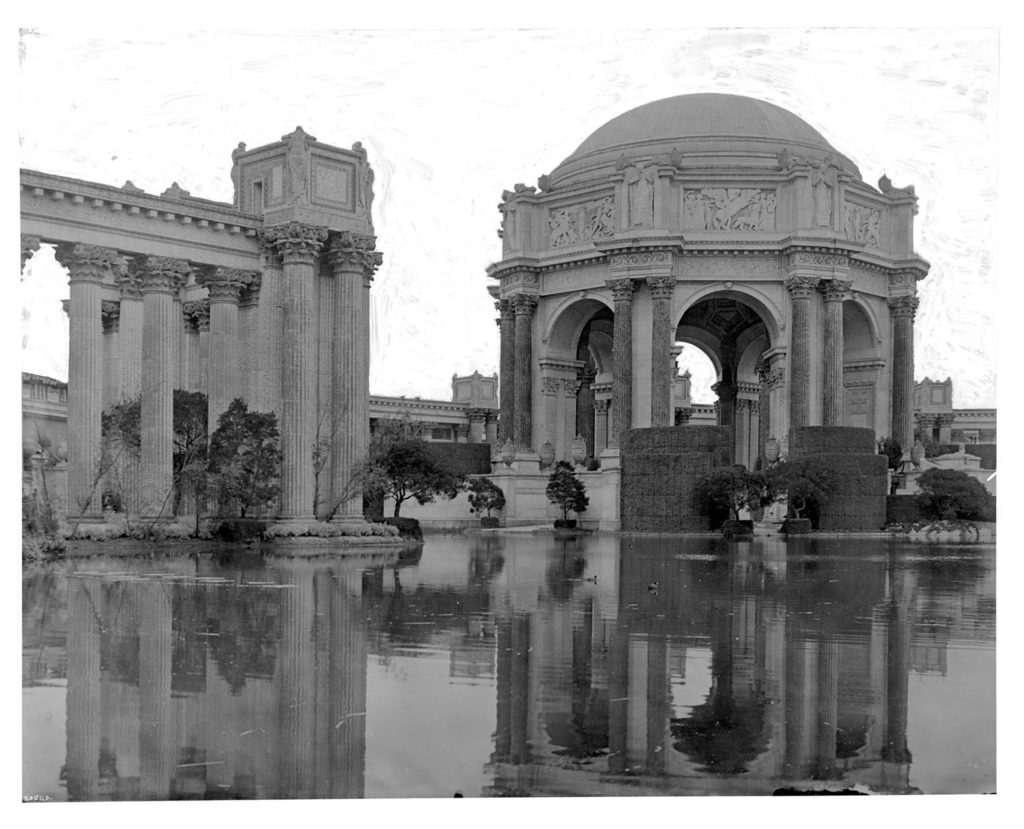
The Bancroft Pictorial Processing Unit is proud to announce that The Edward A. Rogers collection of Cardinell-Vincent Company and Panama-Pacific International Exposition Photographs has been organized, archivally housed, individually listed, and made (substantially) available online. This work was accomplished over two years, thanks to grant support from the National Endowment for the Humanities and, of course, careful hard work on the part of many library staff.
In this blog posting, Project Archivist Lori Hines describes some of the most challenging (and rewarding) work; preserving and providing access to fragile and often damaged glass negatives.
Handling Glass Plate Negatives: A Lesson in Mindfulness
The Rogers collection of Panama Pacific International Exposition photographs, received as a gift in 2014, includes over 2,000 glass negatives. These fragile items required special handling and archival containers with padding. Hardest to work with were approximately 150 oversize glass negatives ranging from 11 x 14 inches to 12 x 20 inches. Antique glass can become brittle and, of course, is heavy. From handling to wheeling the negatives back and forth to the conservation department and the digital lab, one had to be very conscious of every move and step taken.
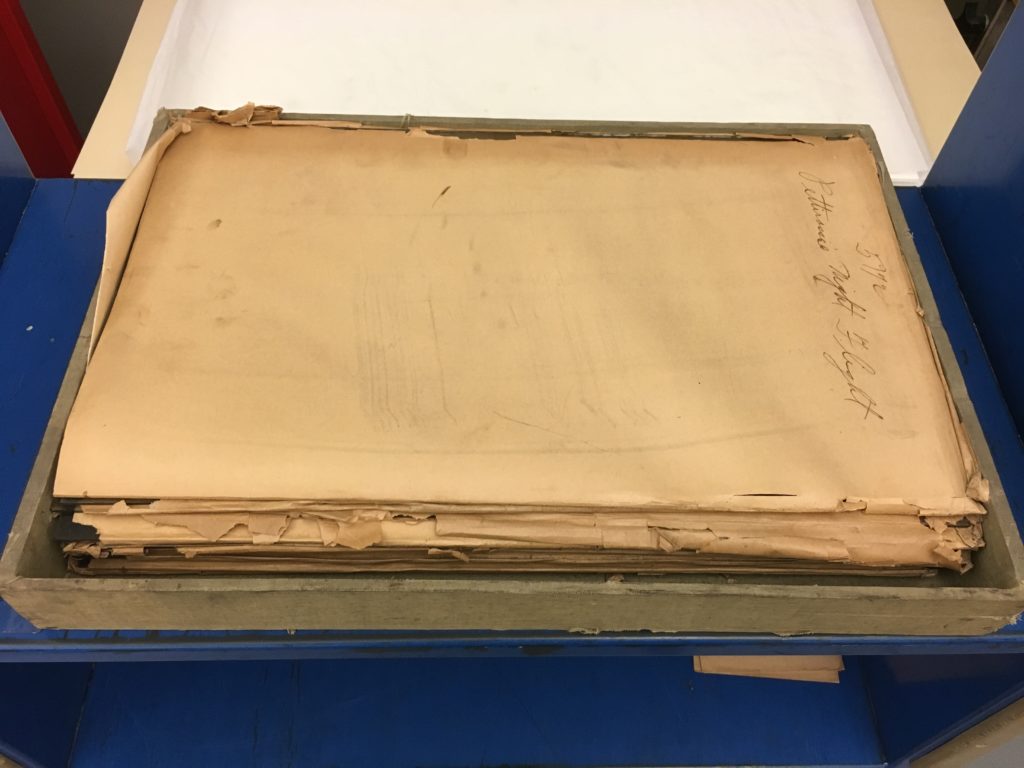
This first photo shows how the negatives were received in the library. Note they have no padding between the plates and there are only original, brittle sleeves to protect them. A stack of ten or fifteen is very heavy and getting your fingers under one, to lift it off the stack, is challenging. The weight of the negatives on top of each other is also a risk — the antique glass can easily crack under the weight.
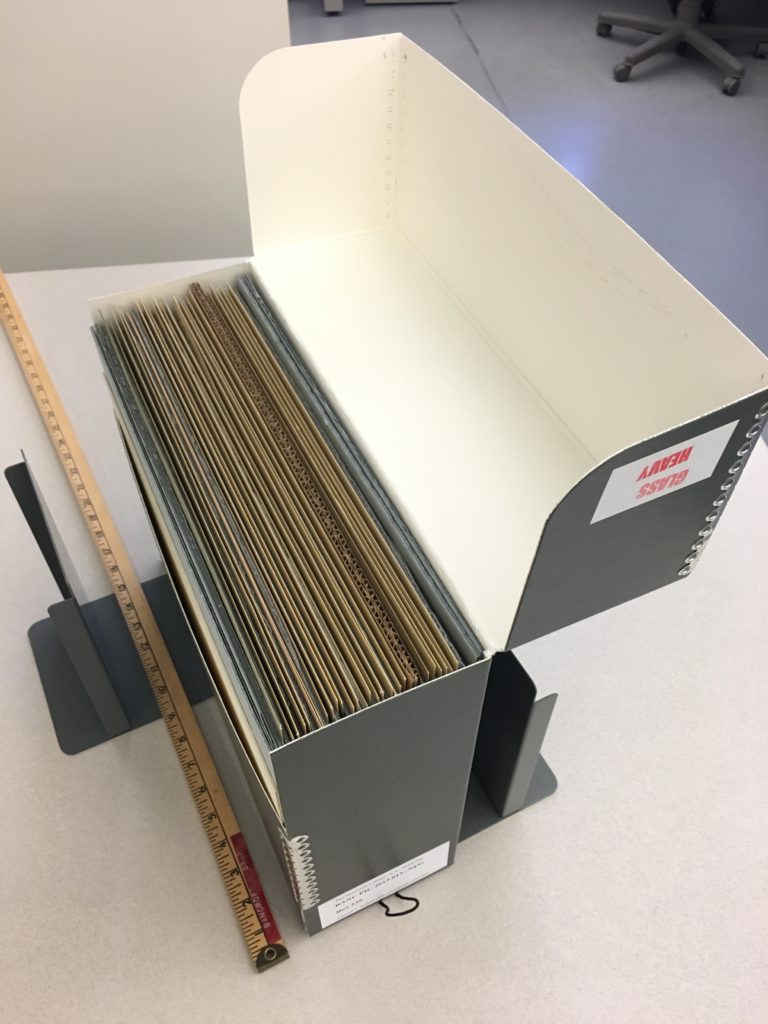
This photo shows how the negatives have been housed by library staff; vertically with corrugated archival cardboard around each. Our library conservators designed the housing to limit box weight, to provide protective padding, to protect the plates from abrasion as they’re removed, and to make handling safer.
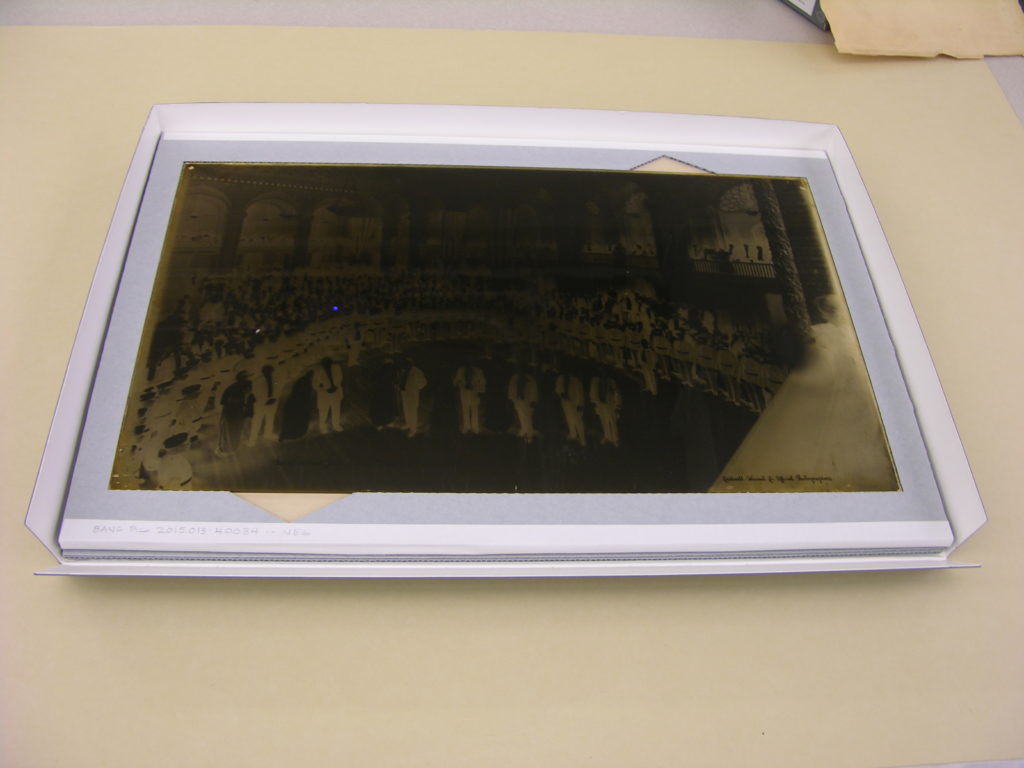
The largest plates, at 12 x 20 inches, needed another housing solution because it was impractical to store them upright, but the weight of one on another was a concern. The Library’s Conservation Department built custom trays to hold each 12 x 20 negative, with just three plates (and their trays) in an archival box that is stored flat on a cabinet shelf.

The negatives are handled on the long side of the glass to offer best support and, during the cleaning, housing, and inventory process, are rested on a piece of thin foam padding to buffer any impact with the work table.
About 10% of the negatives arrived broken. To be digitized, we had to re-piece the broken negatives together on a supporting sheet of glass, like a puzzle, then hand it off immediately to the photographer in the Library’s Digital Imaging Lab. The glass sheet with the broken negative on top was then placed on a light table, so it was lit from behind, to be captured by the digital camera. The light table and camera are visible in the background of this image.
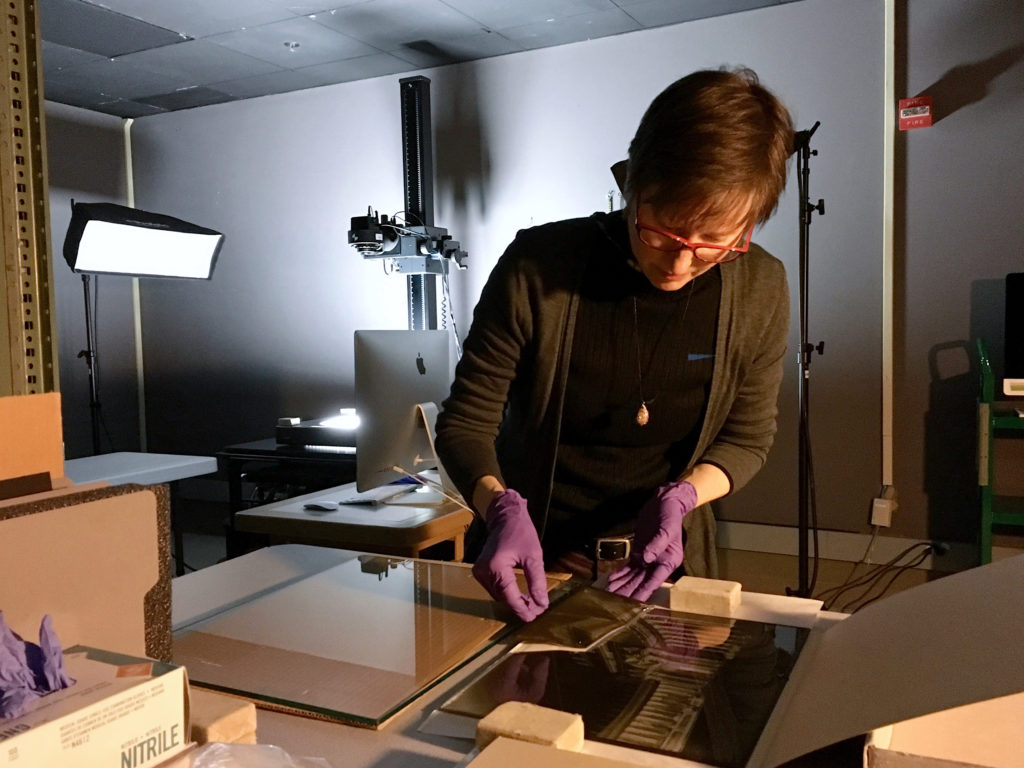
The results were often quite satisfying, as can be seen in this example of a badly broken glass negative that was pieced together.
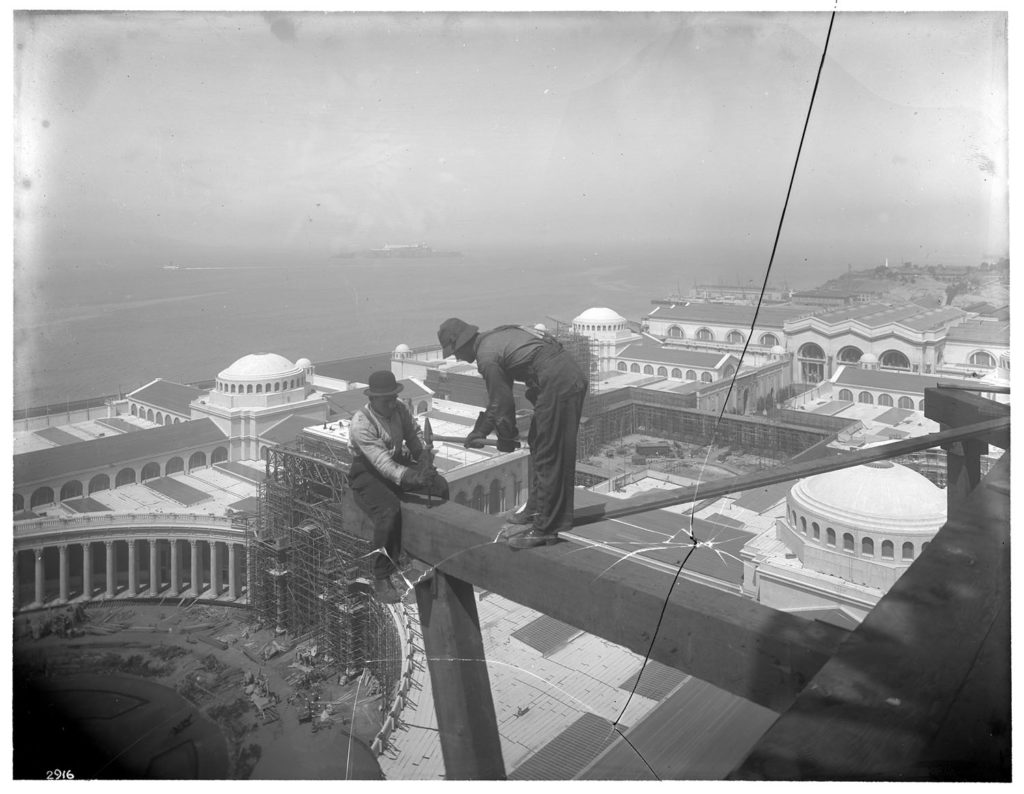
The finding aid describing and listing the entire Rogers collection, with more than 2,000 digital images, may be viewed at the Online Archive of California.
To browse examples of images scanned from broken plates, try searching the finding aid for “negative is broken”, and navigating through the results, or by browsing this Calisphere website search that retrieves just the broken-plate images.
Special thanks go to Christine Huhn and the staff of the Digital Imaging Lab; Hannah Tashjian, Erika Lindensmith, Martha Little, and Emily Ramos of the Conservation Department; staff of the Library Systems Office and the California Digital Library that worked with us to get the material online; to Gawain Weaver Art Conservation (contractors for preservation and scanning of panoramic film negatives), and to the Bancroft Pictorial Unit team that devoted much or their 2016-2018 work life to this effort: Lori Hines, Lu Ann Sleeper, and a crew of student staff.
Event: Bancroft Library Roundtable: “From Kitchen Tables to Laboratories: Nutritional Science at UC Berkeley, 1895-1930”
The third Bancroft Library Roundtable will take place in the Lewis-Latimer Room of The Faculty Club at noon on Thursday, April 19. Kimberly Killion, doctoral candidate in history at UC Berkeley and Bancroft Library Study Award recipient, will present “From Kitchen Tables to Laboratories: Nutritional Science at UC Berkeley, 1895-1930.”
__________________________________________________________
During the late nineteenth century, scientists from various fields began conducting experiments that would change the way most Americans defined, chose, and related to food. Forming the nascent field of nutritional science, this network of scientists included UC Berkeley’s first professor of nutrition, Myer Jaffa, who began conducting research on human nutrition in the 1890s. This research largely took place at the tables of his subjects, where he observed their dietary choices and health. By 1930, when Professor Agnes Fay Morgan led nutritional research at Berkeley, the science had shifted dramatically from field research to laboratory research. Drawing from the Jaffa and Morgan collections housed in The Bancroft Library, Killion will discuss the development of nutritional science on campus during a transformative period in American food history.
We hope to see you there.
José Adrián Barragán-Álvarez and Kathi Neal
Bancroft Library Staff
Event: Bancroft Roundtable: California’s Place in Anti-Slavery Litigation on the Eve of the Civil War
The second Bancroft Library Roundtable talk of the spring semester will take place in the Lewis-Latimer Room of The Faculty Club at noon on Thursday, March 15. Alexandra Havrylyshyn, J.D. and Ph.D. candidate in Jurisprudence and Social Policy at UC Berkeley and Bancroft Library Study Award recipient, will present “California’s Place in Anti-Slavery Litigation on the Eve of the Civil War.”
__________________________________________________________
Between 1846 and 1851 New Orleans trial judge John McHenry ruled in favor of nearly twenty enslaved petitioners who sought freedom on the basis of having touched free soil. These rulings directly contravened Louisiana state legislation, but McHenry reasoned that they were in keeping with higher sources of law: constitutional, federal, and international. He migrated to California, and his personal and legal papers are now preserved in The Bancroft Library. Havrylyshyn’s presentation will explore McHenry’s political identification and the ways that anti-slavery litigation influenced California before the start of the Civil War.
We hope to see you there.
José Adrián Barragán-Álvarez and Kathi Neal
Bancroft Library Staff
Announcing the Release of the California / San Francisco Fire Departments Oral History Project
The world of firefighting is much more than masked people in uniforms running into burning buildings and rescuing scared cats from trees. While the bravery of firefighters can’t be overestimated, they also work in a complex system that requires constant training and education, a cohesive partnership with local government, extensive procedures and protocols, managerial oversight, effective communication within departments and to the public, acute familiarity with the local and regional environment, and a whole lot of administrative work. The San Francisco Fire Department (SFFD) is a shining example of how people make a civil service operation run and keep people safe. All of these elements, as well as the historic and cultural aspects of the department, are why we chose it as our focus for our California Fire Departments Oral History Project.
The project was originally conceived by Sarah Wheelock, an independent researcher. She wanted to explore several major thematic areas of firefighting in California and she worked with the Oral History Center to do just that. With great sadness we learned that Sarah passed away in 2014 and thus she was unable to see the project through to completion. Taking over the project in 2016, I wanted to honor her original plan and cover the themes that she had outlined. So, I decided to embark on interviews within one department – the SFFD – to document the ways in which they have handled urban fire, climate change, diversity, technological change, and changing demographics.
The SFFD was founded in 1849 and was run by volunteers. It became a paid department, officially integrated into city government, in 1866. The 150th anniversary of the paid department was in 2016, when I was conducting interviews. Given my budget for the project, I was able to interview six people who worked with the SFFD in different capacities. I wanted to include multiple perspectives to understand the organizational, cultural, geographic, economic, and political systems of one of the oldest departments in the country.
The individuals who I interviewed were able to illustrate many of the themes that I wanted to document, and much more. Among the six people I interviewed were Chief Robert Demmons (the first and only African American chief of the SFFD who instrumental in integrating more more women and people of color into the SFFD), Bill Koenig (longtime firefighter and co-founder of Guardians of the City and the SFFD Museum), Jim Lee (also a longtime firefighter and co-founder of Guardians of the City and the SFFD Museum), Steve Nakajo (member of the SFFD Fire Commission), Lt. Anne Young (one of the first females hired), and Jonathan Baxter (longtime paramedic and current Public Information Officer).
These interviews work in concert to illustrate day-to-day operations in the stations, administrative duties, how the city of San Francisco and the department work together, the relationship between paramedics and the department, training, equipment, fire science school, the role of unions, the challenges and triumphs of integrating the departments, the public perception of the department, the role of innovation and changing technology, cultural changes in the department, challenges in fire safety particular to the geography of San Francisco, and the hopes for the future of the SFFD.
It is with great excitement that we present the California / San Francisco Fire Departments Oral History Project. I want to give a special thanks to all of the narrators for sharing their stories with me and helping me to document one of the most historically significant fire departments in our country.
This project is dedicated to the memory of Sarah Wheelock. Her California Firefighter oral histories from the 2000s will be released in early 2018.
Exhibit: Bancroft’s New Favorites
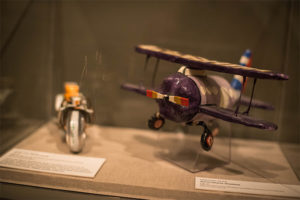
Next week will be the last full week of the Bancroft’s New Favorites Gallery Exhibit, which closes on 1 September.
The gallery is open from 10am-4pm, Monday through Friday, excluding holidays.
For the first time in many years The Bancroft Library presents an exhibition of recent additions to its major collections. The exhibition also includes recently rediscovered masterpieces carefully collected in years past. Gold-Rush-era memoirs and advertisements, early editions of William Langland and Jane Austen, “branded” books from 18th c. Mexico, and David Johnson’s photographs of the African American community in San Francisco after World War II are but a few of the items featured. The exhibition showcases the Bancroft curators and their distinctive collecting practices, which expand the remarkable vision of library founder Hubert Howe Bancroft—documenting California as it was happening and building a library for the American West that would rival its older European antecedents.
